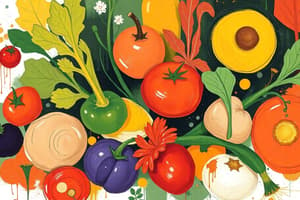Podcast
Questions and Answers
The XTC trends tree has its roots in:
The XTC trends tree has its roots in:
- Exoticism
- Trends
- Axis
- Consumer (correct)
Who said 'Let food be thy medicine'?
Who said 'Let food be thy medicine'?
Hippocrates
Traditional Chinese medicine, Ayurveda and other approaches are trends or movements?
Traditional Chinese medicine, Ayurveda and other approaches are trends or movements?
False (B)
Who said 'Thou shouldst eat to live; not live to eat'?
Who said 'Thou shouldst eat to live; not live to eat'?
A trend signals a ______ shift.
A trend signals a ______ shift.
Which of the following is not a way to identify a food trend?
Which of the following is not a way to identify a food trend?
Which represents the the first stage of a trend life cycle?
Which represents the the first stage of a trend life cycle?
Which decade did the trend of low fat diets emerge?
Which decade did the trend of low fat diets emerge?
Modern food trends usually fit into one of three categories, which of the following is not one of them?
Modern food trends usually fit into one of three categories, which of the following is not one of them?
The slow food movement was founded in 1986 by whom?
The slow food movement was founded in 1986 by whom?
Which of the following are principles of the slow food philosophy?
Which of the following are principles of the slow food philosophy?
What is the name of Fergus Henderson's book on nose-to-tail eating?
What is the name of Fergus Henderson's book on nose-to-tail eating?
The text says that ethical claims on food packages have increased how much since 2020?
The text says that ethical claims on food packages have increased how much since 2020?
Is the restaurant experience a passive experience?
Is the restaurant experience a passive experience?
What is the name of the London restaurant that has on-staff nutritionists to help patrons choose foods?
What is the name of the London restaurant that has on-staff nutritionists to help patrons choose foods?
Flashcards
Food Trend
Food Trend
General development or change in a situation, signaling a permanent shift.
Food Fad
Food Fad
A short-lived style, activity, or interest that is very popular briefly but has no lasting impact.
Embryonic Stage of a Trend
Embryonic Stage of a Trend
Exclusive, rare phase; trend gets airtime from specialists but is financially risky.
Mainstream Stage of a Trend
Mainstream Stage of a Trend
Signup and view all the flashcards
Tapering Off Stage of Trend
Tapering Off Stage of Trend
Signup and view all the flashcards
End Stage of a Trend
End Stage of a Trend
Signup and view all the flashcards
Nouvelle Cuisine
Nouvelle Cuisine
Signup and view all the flashcards
Nouvelle Cuisine Commandments
Nouvelle Cuisine Commandments
Signup and view all the flashcards
Low Fat Diets (1940s-)
Low Fat Diets (1940s-)
Signup and view all the flashcards
Natural Food Trend
Natural Food Trend
Signup and view all the flashcards
Plant-Based Food Trend
Plant-Based Food Trend
Signup and view all the flashcards
Medical Focused Health Trend
Medical Focused Health Trend
Signup and view all the flashcards
Food Guide Serving
Food Guide Serving
Signup and view all the flashcards
Veganism
Veganism
Signup and view all the flashcards
Vegetarianism
Vegetarianism
Signup and view all the flashcards
Health impact of Veganism
Health impact of Veganism
Signup and view all the flashcards
Slow Food
Slow Food
Signup and view all the flashcards
Good Food (Slow Food)
Good Food (Slow Food)
Signup and view all the flashcards
Clean Food (Slow Food)
Clean Food (Slow Food)
Signup and view all the flashcards
Fair Food (Slow Food)
Fair Food (Slow Food)
Signup and view all the flashcards
Farm to Table
Farm to Table
Signup and view all the flashcards
Farm to Table- Pros
Farm to Table- Pros
Signup and view all the flashcards
Molecular Gastronomy
Molecular Gastronomy
Signup and view all the flashcards
Modernist Cuisine Manifesto
Modernist Cuisine Manifesto
Signup and view all the flashcards
Nose-To-Tail
Nose-To-Tail
Signup and view all the flashcards
Zero Waste
Zero Waste
Signup and view all the flashcards
Ethnic Foods
Ethnic Foods
Signup and view all the flashcards
Mindfulness
Mindfulness
Signup and view all the flashcards
Tactile
Tactile
Signup and view all the flashcards
NeuroNutrition
NeuroNutrition
Signup and view all the flashcards
Study Notes
- Trends in Dining, Context, and Projections are being examined and analyzed for Week 3.
Trend Analysis
- Environment, Health, Animal Welfare, Aesthetics, and Ethical/Social/Economic Concerns are all interconnected and influence dining trends.
- Food trends can be approached through a market segmentation lens.
- The XTC trends tree shows trends along the vertical axis and consumer considerations along the horizontal axis.
Early Food Movements
- Hippocrates once said, "Let food be thy medicine."
- Traditional Chinese medicine and Ayurveda aren't considered trends or movements, but systems.
- Ancient food philosophers like Epicurus, Socrates, and Confucius warned against excess in eating.
- Epicurus (341–270 BC) said eating and drinking should be shared experiences.
- Socrates (469-399 BC) stated one should eat to live, not live to eat.
- Confucius (551–479 BCE) believed happiness could be found even in simple meals and comforts.
Trends vs. Fads
- A trend is a general development or change in behavior that signals a permanent shift.
- A fad is a style, activity, or interest that is very popular for a short period with no lasting influence.
Identifying Food Trends
- Look for information from kitchens before they become mainstream.
- Monitor social media, chef discussions, consumer reactions, and posts.
- Pay attention to emerging concepts, designs, and target demographics.
- Observe the supply chain.
- Consider insights and ideas from other industries.
Trend Life Cycle
- Embryonic Stage: Exclusive, rare, and elite.
- Early Adopters: Trend gains visibility but is still uncommon and financially risky.
- Mainstream: Intrepid consumers embrace trend, later, skeptical consumers also adopt.
- Tapering Off: Trend becomes common, replicated by mainstream businesses.
- End Stage: Trend is seen as dated, though best parts remain in use.
Nouvelle Cuisine (1973+)
- Notable figures include Pierre Troisgros, Paul Bocuse, Michel Guérard, Roger Vergé, Louis Outhier, and Alain Senderens.
- Popularized by Henri Gault and Christian Millau, who used the Gault&Millau guide to challenge Michelin Guide's conservative principles.
- The ten commandments include not overcooking, using fresh/quality products, lightening menus, but still being inventive.
- The style has assimilated into mainstream cooking, lightening French cuisine and adding honesty to dishes.
Early Food Trends (Health)
- Low-fat diets became popular in the 1940s.
- Seed oils were used as healthier alternative to animal fats.
- Obesity and cardiovascular disease increased.
- Weight Watchers emerged in the 1960s.
Modern Food Trends (Health)
- Medical: Functional ingredients promote health or prevent/treat disease.
- Paleo Diet: 2002
- Natural: Minimally processed foods that resonate with consumers' perception of "natural" qualities.
- Coconut and “Superfoods”: 2010
- Gluten-Free: 2013
- Plant-Based: Ingredients are derived partly or wholly from plant sources.
- Veganism 2017
- Ketogenic Diet: 2018
- Digestive health 2018
Food Guide Information
- Canada’s Food Guide was revised in 2019.
- There are recommended Daily Serving based on Vegetables, Fruit, Grain Products, Milk, Meat, and Alternatives.
- A single food guide serving can be defined as:
- Grain Products: 1 slice (35 g) bread or ½ bagel (45 g), ½ pita (35 g) or ½ tortilla (35 g), 125 mL (½ cup) cooked rice/pasta/couscous, 30 g cold cereal, or 175 mL (¾ cup) hot cereal
- Milk and Alternatives: 250 mL (1 cup) milk or fortified soy beverage, 175 g (¾ cup) yogurt, or 50 g (1 ½ oz.) of cheese
- Vegetables and Fruit: 125 mL (½ cup) fresh/frozen/canned vegetable or fruit or 100% juice, 250 mL (1 cup) leafy raw vegetables or salad, or 1 fruit
- Meat and Alternatives: 2 eggs, 30 mL (2 Tbsp) peanut butter, 175 mL (¾ cup) cooked beans, or 75 g (2 ½ oz.) or 125 mL (½ cup) cooked fish/shellfish/poultry or lean meat.
Vegetarianism and Veganism
- Reasons for reducing meat consumption include health, weight management, animal welfare, environment, and concerns over antibiotics.
- Approximately 7.6% of Canadians are vegetarians, and 4.6% are vegans as of 2020.
- Around 5% of people in the USA are vegetarians, and 3% are vegans as of 2018.
- In the UK, 25.8% are vegetarians, and 4.4% are vegans, based on 2019 data.
- Switching entirely to plant-based overlooks grazing animals.
- There are questions on the ethics of crops requiring fertilizer, fungicides, pesticides, and herbicides.
- Vegan has the potential to mitigate meat consumption in a healthy way.
Slow Food
- Founded in 1986 by Carlo Petrini in Bra, Italy.
- Movement promotes quality in foods in contrast to "fast food."
- Focus revolves around preventing the loss of local food cultures, traditions, and practices.
- The Ark of Taste collects quality products from cultures across the planet, including fruits, vegetables, animal breeds, cheeses, breads, sweets, and cured meats.
- Good: Ensuring quality, flavorful and healthy food.
- Clean: Production methods that do not harm the environment.
- Fair: Providing accessible prices for consumers while ensuring fair conditions and pay for producers.
- Slow Food Foundation for Biodiversity (founded in 2003).
- The Terra Madre Foundation was founded in 2004 to grow a global network of food communities.
- University of Gastronomic Sciences (UNISG) opened in 2004 to educate future food professionals.
Farm to Table
- Promotes sourcing ingredients directly from local farms rather than through long and distant supply chains.
- The produce is picked when ripe, better flavor and nutrient suited for simple preparations.
- This allows Synergies from a restaurant concept with well-chosen farms.
- There are challenges with growing skepticism about the claims with consumers, which can lead to fraud.
Modernist Cuisine
- It originated from Molecular Gastronomy after misunderstanding of the movement caused chefs to abandon the Molecular Gastronomy movement.
- Excellence, openness, and integrity form the manifesto.
- Cooking builds on traditions via methods by chefs.
Other Trends
- Nose-To-Tail eating that involves using the entire animal.
- Zero Waste efforts.
- Ethnic Foods have a typical rotation of 3 years.
The Problem with Calling an Ethnic Cuisine a Trend
- By Khushbu Shah, Published on 8/3/2017
- The trend is based solely on the approval of white people.
Mindfulness
- Understanding everything possible about a particular food and supporting the aligned company increases.
- Ethical claims on packages have increased.
Tactile
- Multi-sensory is being applied in many areas relating to food.
- Autonomous Sensory Meridian Response, or ASMR is a new food media trend.
- Restaurants are trending towards active one.
NeuroNutrition (and Biohacking)
- Diet is the #1 cause of death due to preventable metabolic disorders.
- NeuroNutrition links food and the brain, considering growing, cooking, when/how we eat, and nutrients.
- "Brain claims" have increased by 36% in the last five years, especially in sports nutrition and cereals.
- BioHacking is geared towards individual nutrition and products.
- London's Squirrel Restaurant uses nutritionists to help patrons choose food.
Studying That Suits You
Use AI to generate personalized quizzes and flashcards to suit your learning preferences.




